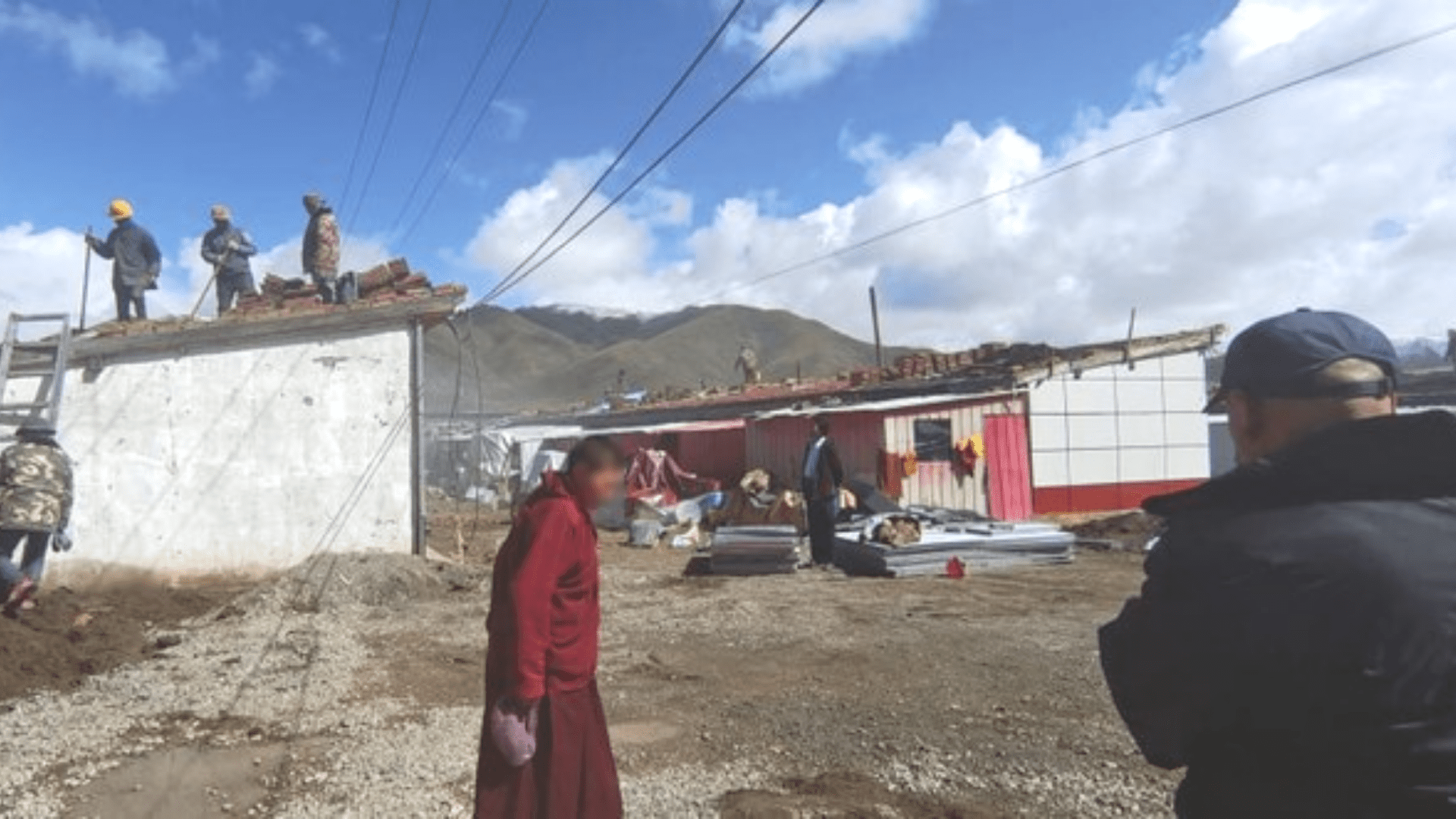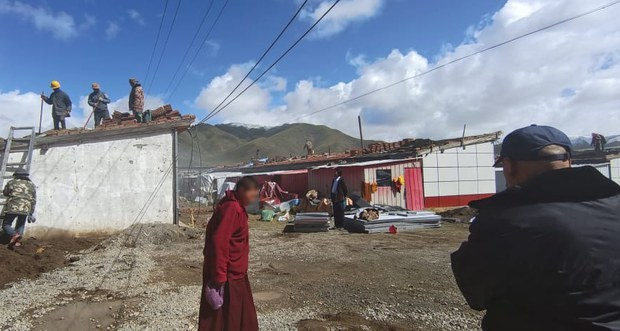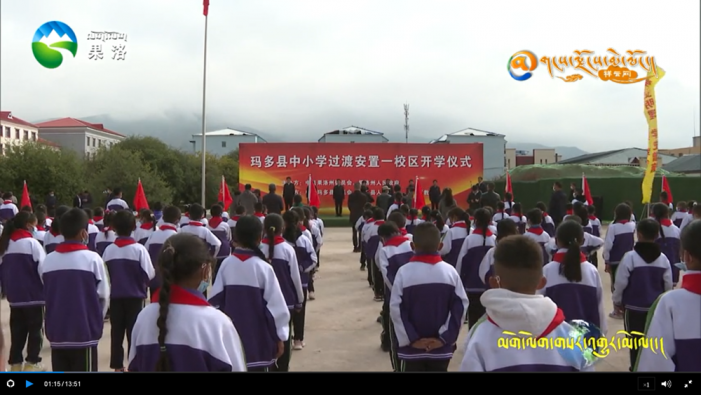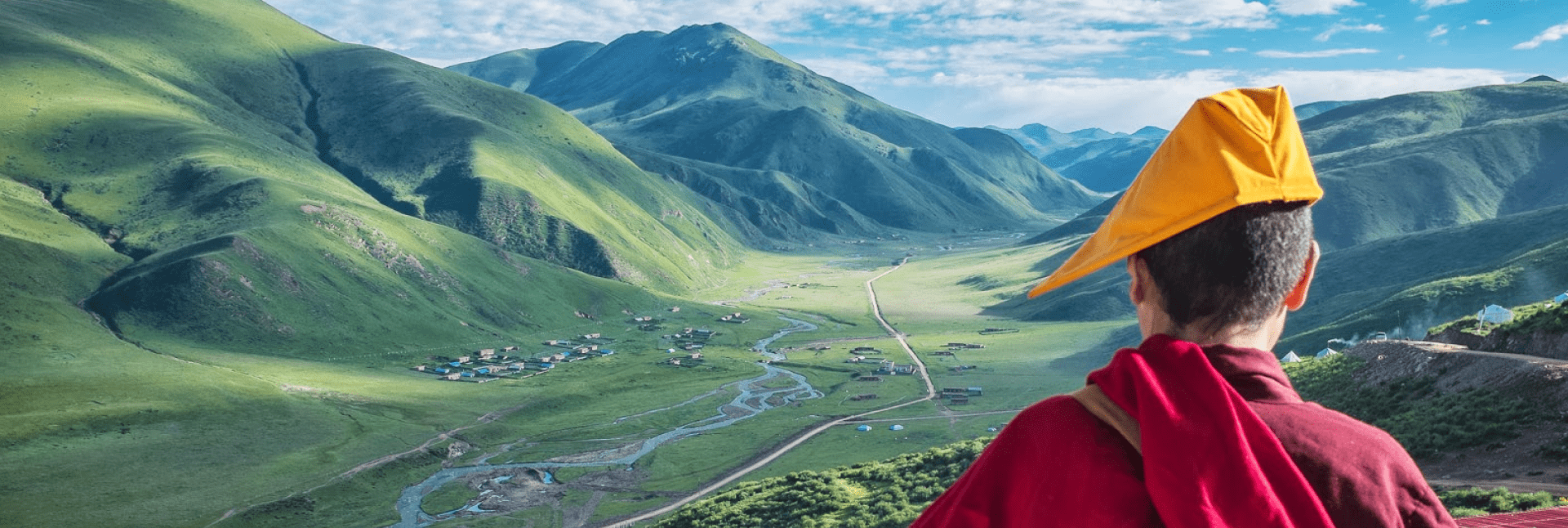
Survivors Of Earthquake Under Surveillance And Uncertainty
Tibetan homes torn down for reconstruction and 1,216 children relocated to distant boarding schools
Tibet Watch has received reports that in early September this year, Chinese authorities in Matoe County (Ch: Maduo, Tib: རྨ་སྟོད་རྫོང་།) of Golog Tibetan Autonomous Prefecture in eastern Tibet started demolishing Lungkya monastery (Tib: ལུང་སྐྱ་དགོན།), an unidentified nunnery and a number of Tibetan homes as part of infrastructure reconstruction following the 7.4 magnitude earthquake that happened on 22 May 2021. The demolitions are being carried out regardless of whether or not the houses were damaged by the earthquake. All the monks, nuns and residents were forced to temporarily take shelter in the newly built camps with steel roofs.

Reconstruction of buildings in Matoe County
A source from the area confided that “the demolition of Lungkya monastery and nunnery started a month ago but the authorities have still not yet given any information about when it will end and when the reconstruction would be completed. They have only told us about rebuilding a better monastery and its assembly hall.”
Explaining further on the uncertainty of their situation, the source added, “Local residents worry about how long they might remain under the steel roof shelters. The main concern of local people is that they are uncertain if the Chinese authorities would reconstruct the monastery and Tibetan homes after everything is torn down. Many homes were neither damaged nor affected by the earthquake but the authorities forced the residents of those unaffected homes to move to the camps along with others and even proceeded with demolishing the houses.”
The local government authorities have warned local residents not to share or post any pictures, videos or updated information on the demolition and activities currently underway on social media for security reasons.
RAISE YOUR HANDS
In addition to this restriction on information sharing, the Chinese authorities held a public meeting regarding the relocation of all the students from the affected areas to Chinese-government-run schools in Xining city (Tib: ཟི་ལིང་གྲོང་ཁྱེར།), Golog County (Tib: མགོ་ལོག་ཁུལ་ཐོག) and Zogan Rawar township (Tib: མཛོ་རྒན་རྭ་བར་གྲོང་རྡལ།), the source explained. At the meeting, parents were instructed to raise their hands if they accepted the relocation as arranged by the government. However, they found themselves in a situation where no option to refuse was at their disposal.
Most of the Chinese state media’s coverage in English of Matoe County since the earthquake is replete with a particular emphasis on school children: students continuing their classes in disaster relief tents, celebrating children’s day a week after the earthquake, and school reopening in their transitional schools. Tibetan parents in the region remain concerned about the lack of education in Tibetan in those new boarding schools. The so-called Qinghai government has since 2010 implemented Model 2 of bilingual education which prioritises the national language (Putonghua) as the medium of instruction in classes with minority pupils.
The Qinghai Provincial website reported on 2 September 2021 that 1,772 students from the earthquake-hit counties were relocated to six different schools. The same report cited that around 400 students were relocated to Vocational Training School of Golog County. Another state news report on the Chinese messaging app QQ and a video report published in a Golog-specific Tibetan news channel confirmed that 1,216 students from Matoe County were relocated. The latter report mentioned that the students will be living there for two to three years.

Opening ceremony of the first campus for the transitional placement of primary and secondary students of Matoe County
RESETTLEMENT AFTER RESETTLEMENT
Tibetans in Amdo, which is governed as Qinghai, have previously undergone forced eviction from their ancestral lands since 2000 when the “West Development Strategy” was launched. The evictions en masse gradually came to be also described in the Chinese term ‘shengtai yimin’ translated as “ecological resettlement”.
In the early 1980s, the term was previously used for “relocations” of people from eastern neighboring Ningxia from their degraded land. It was later adopted for relocations carried out by the state in its 13 western provinces, including Amdo, for the implementation of poverty alleviation policy (Tib: དབུལ་སྐྱོར་མཁྲེགས་གཏོར་ལས་གཞི།་།).
Following the establishment of Sanjiangyuan Nature Reserve in 2003 and the State Council’s approval of the General Plan for the Preservation and Reconstruction of Qinghai’s Sanjiangyuan National Nature Reserve Area in 2004, an unprecedented relocation of 55,774 people was initiated along with reduction of livestock population by 3.2 million sheep units. Matoe County is situated in the core area of this nature reserve where local populations in thousands were displaced in the name of grassland protection. As the source of Asia’s three largest transboundary rivers of Machu, Drichu and Zachu.
Contrary to the government narrative which largely blamed overgrazing for the degradation of grassland in Madrizasum region, local Tibetans and officials of Matoe County pointed out that warmer temperature, rampant gold mining by non-locals, poaching-induced proliferation of pika (a small rodent native to Tibet) and improper grassland management by the state caused grassland degradation. In 1986, more than 10,000 gold-miners from eastern Amdo swamped the local Tibetan population of 9,466, leading to conflicts that left 231 people wounded, one dead, and a trail of destruction and pollution to their homeland. By 2007, Matoe government had resettled 22.7 percent of the local nomadic population into four newly established villages, the distance from their original homeland ranging from 30 to 450 kilometres.
A five-year field investigation (2005-2009) by a team of researchers to study the impact of resettlement on Tibetan nomads in Madrizasum concluded that “…even though government and individual nomads made the decision to do their best with resettlement and to protect the grassland, Sanjiangyuan Natural System, so far the experiment has not been successful for the nomads or for the government”.
On 14 April 2010, a decade before this year’s 22 May earthquake, the same province’s Yushu Tibet Autonomous Prefecture witnessed another cataclysmic earthquake of 7.1 magnitude claiming thousands of lives and inflicting extensive damage to infrastructure including resettlement villages of Tibetan nomads.
Reminded of the injustice and reconstruction of resettlement villages that followed the Yushu earthquake, one of the Tibetans in Matoe County reported to Radio Free Asia that none of the local Tibetans were consulted for the reconstruction projects and they worry that the newly built homes would not resemble any Tibetan characteristics. The source added that at least 20 died and 300 were injured.
In the span of nearly two decades, Tibetans of Matoe County have navigated through their vulnerable and disappearing tradition of pastoralism and created a community in their new resettlement villages. Many have also taken up jobs under the government’s “ecological rangers” programme to monitor and report on the health of the grasslands.
The Machu river is also being diverted from Amdo as part of China’s‘Water Diversion and Infrastructure of the Western Development Program’. The engineering of the river flow from the south to supply water in the parched north continues whilst climate-related disasters increase in frequency and intensity. Residents have for so long been worried that their economy has dried up with its nearby wetland, reported The Guardian on 2 September 2010.
As Tibetan parents raise their hands to send their children away to post-earthquake boarding schools, their life of resettlement after resettlement remains rife with uncertainty about their homes, places of religious faith, and Tibetan education for their children.
Information supplied by Tibet Watch

